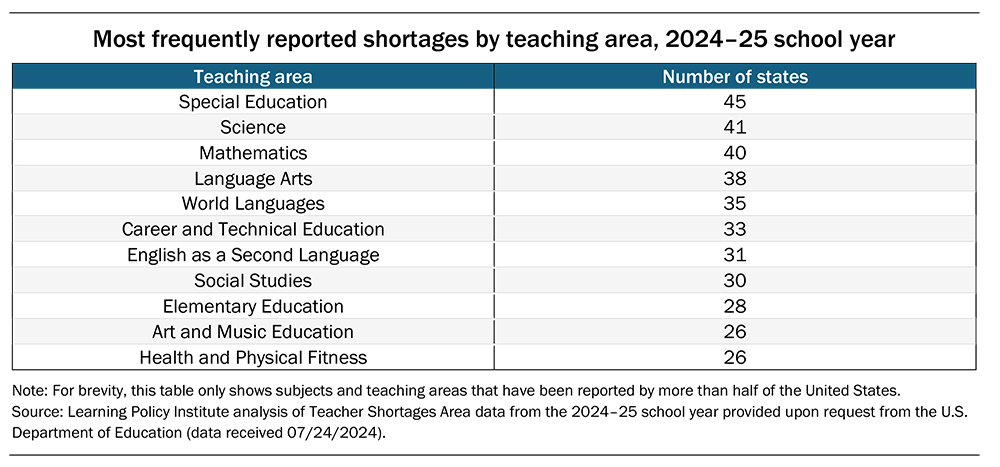Teacher Shortages by Subjects Across States
Access State Teacher Shortages 2025 Update for more information.
Note: The Department of Education’s public database displays select results and does not show all reported information about teacher shortages. LPI analysis used the complete dataset provided by the Department of Education. For the 2024–25 school year, New Hampshire did not report any data.
How do teacher shortages impact students and school districts?
Districts and schools across the nation struggle with persistent teacher shortages. These shortages affect all types of districts, from rural to urban, and all states small to large. Shortages have particularly negative consequences for:
-
Student learning. When districts and schools face shortages, they often hire underprepared teachers or teachers not fully certified for their assignments; staff classrooms with substitute teachers; increase class sizes; cancel courses; and add responsibilities to existing teachers. All these things undermine student achievement.
-
Students from lower-income backgrounds and students of color. These students often have the most limited access to certified and experienced teachers and are disproportionately impacted by teacher shortages. Schools with the highest concentration of students of color are 4 times as likely to employ an uncertified teacher compared to schools with the lowest concentrations.
-
District budgets. Teacher shortages are primarily driven by teachers leaving their schools and profession, harming not only student achievement but also district finances. Districts incur costs that total between about $12,000 and $25,000 for every teacher who leaves, depending on district size. These include the costs to separate from teachers who leave, as well as costs to recruit, hire, and onboard new teachers.
-
Rural districts. Rural districts are particularly impacted by teacher shortages due to smaller tax bases that prevent rural districts from offering competitive salaries, greater distance from educator preparation programs, and difficulty filling vacancies that result in higher reliance on out-of-field teachers.
Where are teacher shortages most severe?
Every year, states report data to the U.S. Department of Education on state teacher shortages, including which subjects, fields, and geographic areas have shortages and the severity of each shortage. The following table shows the number of states reporting shortages by teaching area.

Analyses of these federal data show that, in the 2024–25 school year:
-
Every state and Washington, DC reported shortages in more than one teaching area. These shortages ranged from teachers in general elementary classrooms to career and technical education in secondary schools.
-
States most commonly reported shortage areas in special education (45 states), science (41 states), and math (40 states). Collectively, 48 states reported shortages in at least one of these three teaching areas—areas that have had shortages since at least 1990, when the Department of Education began collecting these data.
-
The numbers of shortage positions were deepest in special education, elementary education, language arts, and career and technical education. These teaching areas account for the highest numbers of teacher shortages nationwide, as measured by the number of positions that are vacant, filled by temporarily certified teachers, or filled by out-of-field teachers.
In addition to reporting to the federal government, state education agencies also separately publish information on shortages. A 2025 analysis of state-level data from the most recent school years found that, nationally, 1 in 8 of all teaching positions—over 410,000—were left vacant or filled by teachers not fully certified for their assignments.
What can policymakers do about teacher shortages?
Local, state, and federal education leaders and policymakers all play important roles in reducing pervasive teacher shortages. Research suggests the following strategies are key to building a strong and stable teacher workforce:
-
Invest in high-quality, widely accessible pathways into teaching. Teachers receiving high-quality, comprehensive preparation, like those offered by teacher residencies, tend to stay in teaching longer and are more effective.
-
Provide beginning teachers with mentoring and induction supports. New teachers who are mentored and well supported become effective sooner and stay in teaching longer than those who lack mentoring and support.
-
Provide competitive compensation and improve working conditions. Turnover is one of the key causes of teacher shortages because most open positions are created by teachers leaving the profession before retirement. Increasing teacher compensation and improving working conditions positively impact recruitment and retention efforts.
-
Strengthen data accessibility and data system infrastructure. Access to data that is consistent, accurate, transparent, timely, and routinely updated enables policymakers and stakeholders to better understand teacher shortages and devise informed policy solutions.
